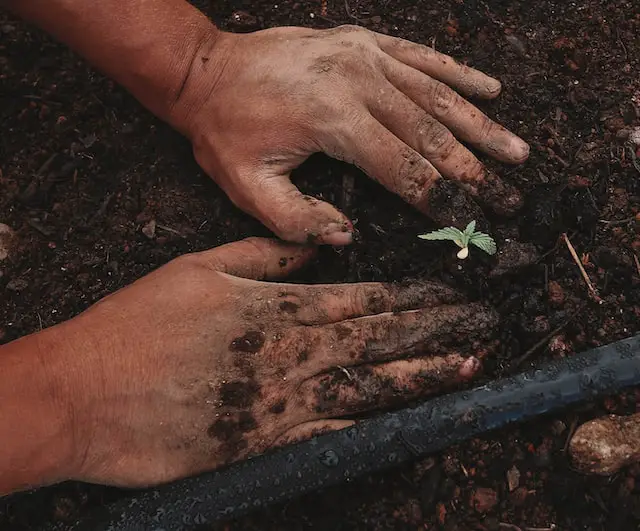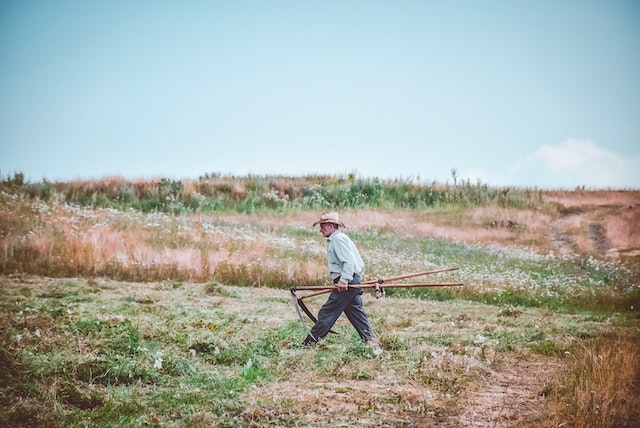Yeoman were independent farmers who owned their own land and typically kept small farms with a few animals or crops while plantation owners ran large scale operations with hundreds of enslaved people working to cultivate huge plantations. Plantation owners had much more economic power than yeomen and often held political offices as well. The differences in labor, economic class, social status, and agricultural practices are important distinctions that historians must consider when studying the history of these two groups.
The Yeoman farmer
(Photo by GreenForce Staffing on Unsplash )

The yeoman farmer is a term used to describe a type of farmer who owned a small plot of land and worked it with their family, using mostly manual labor and basic tools. The term “yeoman” originally referred to a free man who owned a small piece of land in medieval England, but it later became associated with the idea of the independent farmer in the United States.
Yeoman farmers played an important role in the early agricultural economy of the United States. They often grew crops such as wheat, corn, and tobacco, and raised livestock such as cattle, sheep, and pigs. They were also involved in trade and commerce, often selling their goods to local markets or to merchants who would transport them to other parts of the country.
Many yeoman farmers were known for their self-sufficiency and their ability to make do with limited resources. They were skilled at repairing and building their own tools and equipment, and they often relied on their own labor rather than hiring outside help. Yeoman farmers were also known for their strong work ethic and their dedication to their families and communities.
Although the role of the yeoman farmer has changed over time with the development of industrial agriculture and other changes in the economy, the idea of the independent small farmer remains an important part of American culture and history.
The Plantation owner
(Photo by Toan Pham)

The plantation owner is a term used to describe a person who owned a large agricultural estate, known as a plantation, typically in the southern United States. Plantation owners were primarily involved in the production of cash crops such as cotton, tobacco, sugar, and rice, which were labor-intensive and required large amounts of land and enslaved labor.
Historically, many plantation owners in the southern United States relied heavily on the labor of enslaved people, who were forced to work long hours in brutal conditions. The exploitation and mistreatment of enslaved people was a major factor in the economic success of many plantations, and the legacy of this system of exploitation continues to be felt in many ways today.
Plantation owners were often members of the planter class, a social and economic elite that held significant political power in the South. They were typically wealthy, educated, and influential, and their wealth and status often allowed them to exert significant influence over local politics and society.
Although the plantation system and the ownership of large estates has largely disappeared in the United States, the legacy of plantation culture and the exploitation of enslaved people continues to be an important part of American history and a subject of ongoing study and discussion.
The difference between the two
In the United States, a yeoman farmer is someone who owns and operates a small farm. A plantation owner, on the other hand, is someone who owns a large farm that relies on slave labor to produce crops.
The two terms are often used interchangeably, but there is a difference between yeoman and plantation owners. A yeoman was a small farmer who owned his own land and worked it himself, while a plantation owner was a wealthy landowner who employed others to work his land for him.
Plantation owners were typically wealthy landowners who had many slaves working for them. Yeoman farmers, on the other hand, were usually small-scale farmers who worked their own land.
Another difference is that plantation owners generally grew cash crops like tobacco or cotton, while yeoman farmers tended to grow food crops like wheat or corn. And finally, plantation owners usually lived in luxurious mansions, while yeoman farmers usually lived in more humble homes.
Why the plantation system was created
The plantation system was created in the American South to provide a labor force for the region’s growing agricultural and commercial industries. The plantations were large farms or estates that were usually worked by slaves. The plantation owners were typically wealthy planters who controlled a great deal of land and had a large number of workers.
How the plantation system changed over time
The plantation system changed over time from one based on small family farms to one dominated by large commercial operations. This change was driven by a number of factors, including the increasing availability of slaves, the expansion of the settlement frontier, and the growth of the international market for cash crops. The result was a more efficient and profitable system of agriculture, but one that was also more brutal and inhumane.
The impact of the plantation system today
The plantation system had a profound impact on the development of the United States. It shaped the economy, social structure, and political landscape of the country. Today, the legacy of the plantation system can still be seen in many aspects of American life.
The plantation system was based on large-scale agriculture and the use of slave labor. This model of production was extremely profitable for those who owned plantations. However, it had devastating consequences for the slaves who were forced to work on them.
The plantation system created a class of wealthy landowners and a class of poor, exploited workers. This division between rich and poor has persisted throughout American history. Today, income inequality is still a major issue in the United States.
The plantation system also had a significant impact on race relations in the United States. Slavery was integral to the operation of plantations, and racism was used to justify it. The legacy of slavery and racism is still felt today in America. African Americans continue to face discrimination and disparities in many areas of life.
The plantation system was an important part of American history, and its effects are still evident today. Understanding its impact can help us to address some of the challenges that we still face as a nation.
What do plantation owners do?
Plantation owners typically owned large tracts of land and cultivated them with the help of slave labor. They grew crops such as tobacco, rice, and cotton for export and often amassed great wealth. Some plantation owners also operated businesses or factories on their properties. While the life of a plantation owner was generally one of luxury and privilege, it was also marked by hard work and strict social rules.
What do Yeoman farmers do?
Yeoman farmers are small, independent farmers who own their own land and equipment. They are self-sufficient and produce most of what they need to live on their own farms. Yeoman farmers usually sell their surplus crops and animals at local markets.
Did Yeoman farmers have slaves?
Yes, some Yeoman farmers did have slaves. Though the Yeoman farmer class was not as wealthy as plantation owners, they still had enough money to purchase slaves. These slaves would then do the same work on the Yeoman farms as they would on plantations, such as planting and harvesting crops, cooking and cleaning.
Who were the new plantation owners?
In the 1600s, the English colonies in North America were primarily populated by farmers known as yeomen. However, by the early 1700s, a new class of wealthy landowners had emerged: the plantation owners.
Plantation owners were typically large-scale farmers who owned extensive tracts of land and enslaved Africans to work on their plantations. Many of these landowners were members of the upper class and had significant political and economic power.
The plantation owners’ way of life was very different from that of the average farmer. They lived in lavish mansions and enjoyed a lifestyle of luxury and privilege. Their plantations were often much larger and more profitable than the small farms operated by yeomen.
While the plantation owners constituted a tiny minority of colonists, their wealth and power made them a significant force in colonial society.
What was life like for a plantation owner?
Life for a plantation owner in the southern United States was typically characterized by wealth, privilege, and power. Plantation owners were often members of the planter class, a social and economic elite that held significant political power in the South.
Plantation owners lived in large, often luxurious homes, and enjoyed a wide range of amenities and privileges that were not available to most people of their time. They were able to travel extensively, often visiting other parts of the country or even Europe, and were able to provide their families with a high standard of living.
Plantation owners typically relied on the labor of enslaved people to run their estates, and thus were able to devote themselves to managing their property, overseeing agricultural production, and pursuing other interests and hobbies. They often employed overseers or managers to run the day-to-day operations of their plantations, and had access to a wide range of services, such as legal advice and medical care.
Despite the many privileges enjoyed by plantation owners, life was not without its challenges. Managing a large agricultural estate was a complex and demanding task, requiring significant expertise in areas such as farming, finance, and logistics. Additionally, plantation owners were often subject to economic and political pressures that could impact their fortunes and their standing in the community.
The life of a plantation owner was also shaped by the realities of the society in which they lived, including the system of slavery that was integral to the southern economy. While some plantation owners were critical of slavery, many others were deeply invested in the exploitation of enslaved people, and the legacy of this system continues to be felt in many ways today.
Featured Image By – Photo by vardan harutyunyan








